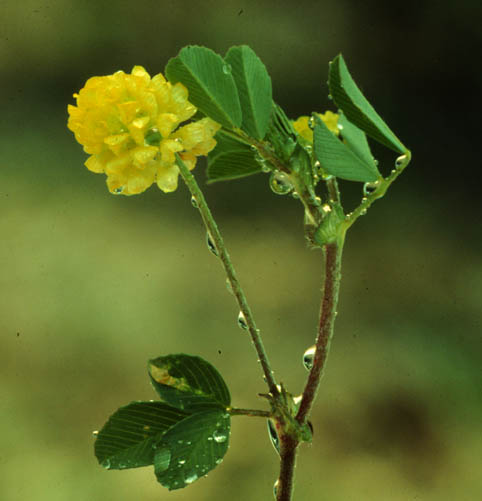
click on the image for a better view!
(photographed by N.E.Thomas)
Author: Stephanie K. Jones
an undergraduate at the University of Georgia, Athens
Biology Education Major
This site was constructed as an Ecology 3500 project May 27, 1999
E-mail Me!
My Permanant Address: stephaniejones@juno.com
My School Address: skj@arches.uga.edu
(back to family page)
By compiling my sources that are listed in the Reference section, I have found a description of Trifolium campestre. These are traits that may help you to identify a T. campestre. This clover is classified as an annual herbaceous plant which is also a stipulate. The plant is three-leaved and can be found between April-October. One important factor that may distinguish the Low Hop Clover from other clovers is that the terminal leaflet is distinctly stalked. Petioles of T. campestre are usually shorter than the leaflets. These leaflets are toothed. The shape of the leaves range from ellipsoid to oblongoid. Stems are erect and measure 10-30 cm long. The plant has many branched stems that are of a hairy texture. T. campestre produces 20-40 flowers per head and each flower is stalked.
Low Hop clover was an introduced plant to North America but has become naturalized. Trifolium campestre is native of Eurasia and North Africa. This plant has spread to most temperate regions of the world. In the United States, this plant is common from Florida to Eastern Texas. Low Hop Clover, better known as field clover in some areas, has been found around the Pacific slopes and is common in California.(Zohary & Heller 1984)
Identification:
Geography:
Table I: North American Distribution of T.campestre
Trifolium campestre | ||
| AREA | STATUS | REFERENCES |
| North America: Continental United States; Canada |
Yes | Zohary & Heller 1984 |
| Eastern North America: United States east of Mississippi; Ontario and eastern Canada |
Yes | http://plants.usda.gov |
| Southeastern United States: AL AR DE DC FL GA KY MD NC SC TN VA WV |
Yes | Foote & Duncan 1975 |
| Southern Appalachian
States: AL GA KY MD NC SC TN VA WV |
Yes | Smith 1988 | Coastal Plain | yes | http://plants.usda.gov | Piedmont | Yes | http://plants.usda.gov; |
| Blue Ridge Mountains | Yes | Smith 1988 |
| Great Smoky Mountains National Park | Yes | Smith 1988 |
| Ridge and Valley | Yes | Hickman 1993 |
| Cumberland Plateau | Yes | http://plants.usda.gov |
| Central Arch | ? | - |
| Georgia | Yes | http://plants.usda.gov |
| Clarke County, Georgia | Yes | Foote & Duncan & UGA Herberium |
Trifolium campestre thrives in temperate regions and does not do as well in dry or hot humid climates(Edsall 1985). T. campestre is good for pastures because of their nutritional quality and nitrogen fixing abilty. Although this plant is a weedy plant, it is still valuable as a soil builder. T. campestre displays rapid spring growth(http://www.hort.purdue.edu). Low Hop clover is also known as a food source for some animals and insects although this clover is not eaten as much as it's relative clovers. The plant is usually locally plentiful in the East, but it's value to wildlife is slight(Martin, Zim, & Nelson 1951).
How to Encounter: Where you can find this beautiful clover.
Low Hop clover can be found in meadows, along borders of fields, lawns, roadsides, waste places, and especially in resting pastures. It is easiest to find in the spring, when it flourishes the most(Foote & Duncan 1975).
http://www.hort.purdue.edu/newcrop/Crops/Hop_clovers.html